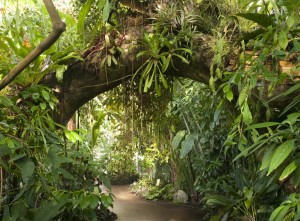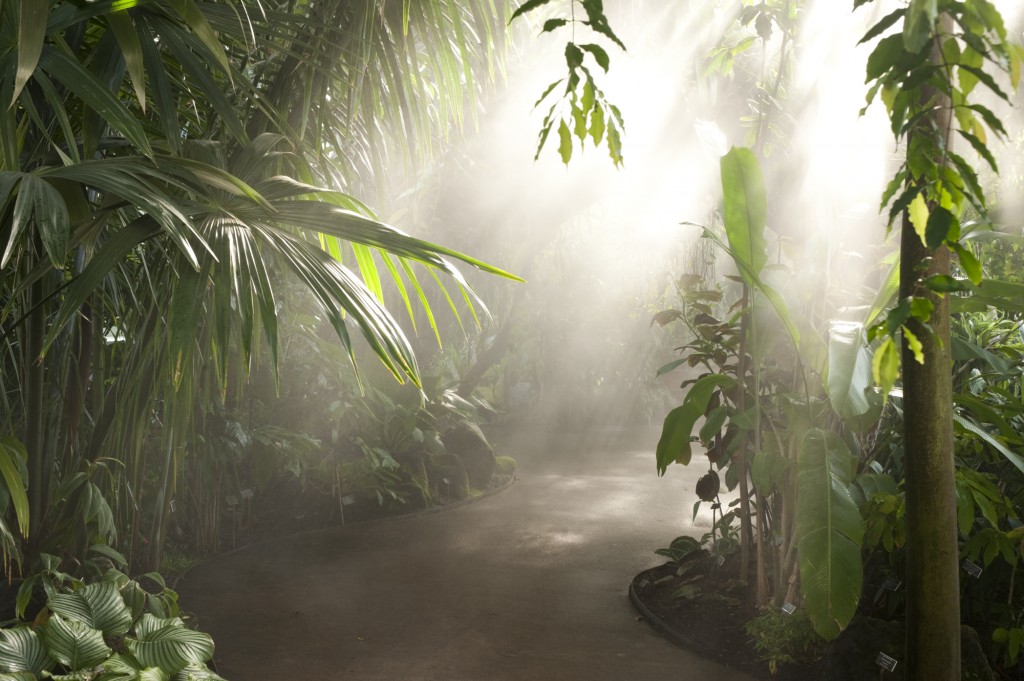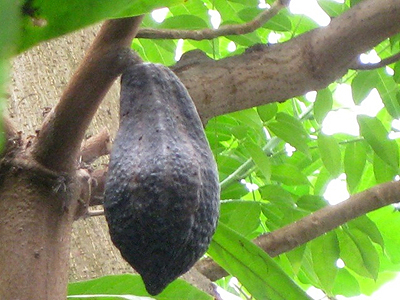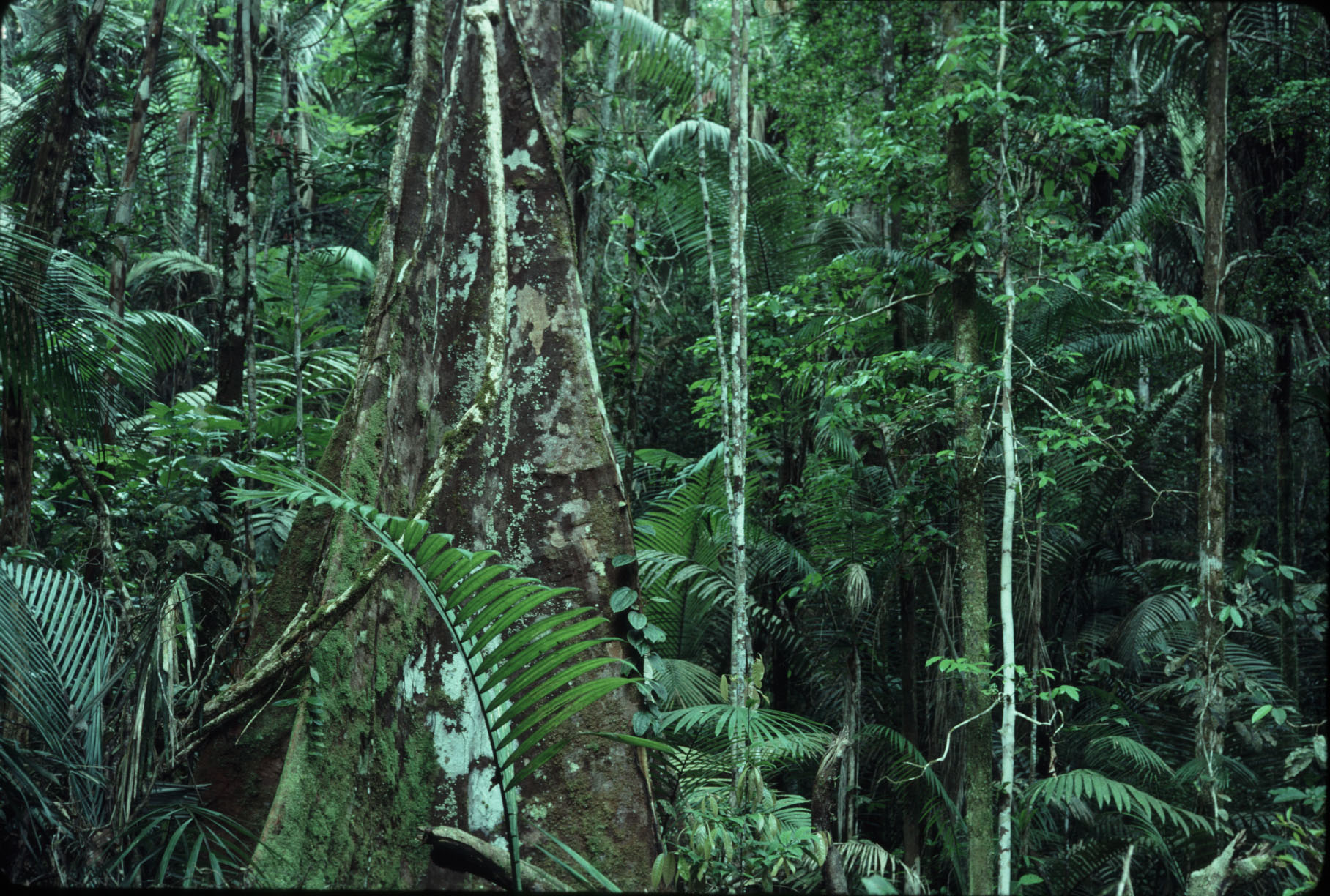Inside The New York Botanical Garden
Rainforest
Posted in Around the Garden, Exhibitions on February 6 2012, by Joyce Newman
Joyce H. Newman is the editor of Consumer Reports’ GreenerChoices.org, and has been a Garden Tour Guide with The New York Botanical Garden for the past six years.
 One of the most dramatic specimens in the NYBG‘s Enid A. Haupt Conservatory rainforest is the gigantic Kapok tree, now part of the Caribbean Garden exhibition. A man-made version–looking very real–arches over the lowland rainforest path, showing off numerous epiphytic plants–orchids and bromeliads–that cling to its sides. Visitors are usually amazed to learn the tree is man-made. Two other examples (one real, one man-made) in the rainforest gallery reach high atop the rainforest canopy.
One of the most dramatic specimens in the NYBG‘s Enid A. Haupt Conservatory rainforest is the gigantic Kapok tree, now part of the Caribbean Garden exhibition. A man-made version–looking very real–arches over the lowland rainforest path, showing off numerous epiphytic plants–orchids and bromeliads–that cling to its sides. Visitors are usually amazed to learn the tree is man-made. Two other examples (one real, one man-made) in the rainforest gallery reach high atop the rainforest canopy.
Read More
Posted in Around the Garden, Photography on January 30 2012, by Matt Newman
Not Costa Rica, Brazil, or the Philippines. Not even the Virgin Islands (though the ongoing Caribbean Garden event in the Enid A. Haupt Conservatory might convince you otherwise).

Photo by Ivo M. Vermeulen
Posted in Adult Education, Around the Garden, The Edible Garden on January 19 2012, by Joyce Newman
Just in time for Valentine’s Day, sign up for “The Temptation of Chocolate” with NYBG expert Jessica Bohn, Saturday, February 11 at the Midtown Education Center.
 Did you know the main ingredient in chocolate comes from the fruit of the cacao tree? Perhaps you read our earlier article on “cauliflory” in trees like this one. Lucky for us there are cacao trees (Theobroma cacao) thriving in The New York Botanical Garden’s tropical rainforest, a part of the Enid A. Haupt Conservatory. In fact, two of our cacao trees now have cocoa bean pods growing on them, each one about six inches long and dark brown.
Did you know the main ingredient in chocolate comes from the fruit of the cacao tree? Perhaps you read our earlier article on “cauliflory” in trees like this one. Lucky for us there are cacao trees (Theobroma cacao) thriving in The New York Botanical Garden’s tropical rainforest, a part of the Enid A. Haupt Conservatory. In fact, two of our cacao trees now have cocoa bean pods growing on them, each one about six inches long and dark brown.
Read More
Posted in Science on February 26 2009, by Plant Talk
 |
Scott A. Mori, Nathaniel Lord Britton Curator of Botany, has been studying New World rain forests at The New York Botanical Garden for 40 years.
|
 Primary rain forest in central Brazilian Amazon
Primary rain forest in central Brazilian Amazon
This forest has as many as 285 different species of large trees in a single hectare (about 2.5 acres) among which are as many as 24 species of the Brazil nut family. The adjacent secondary forest that developed after cutting and burning has as few as one to three different species of large trees and not a single species of the Brazil nut family. Photo by Carol GracieLast month I attended a symposium hosted at the Smithonsian Institution titled “Will the Tropical Rainforests Survive? New Threats and Realities in the Tropical Extinction Crisis” This well-organized and engaging symposium served as the basis for subsequent articles in The Economist and The New York Times that have sparked lively debate. After reading these articles, I was prompted to write this blog to clear up some of the misconceptions that have arisen from the symposium.
(For readers who are not familiar with the terminology used to describe forest regeneration after deforestation, I provide a brief explanation of the process after the jump; see below.)
In the first place, there is no debate about the need to preserve primary forest among biologists who have studied tropical ecosystems. On several occasions the speakers and the moderator stated that the protection of primary forest is still a high priority. Moreover, there was no disagreement that primary forest continues to be destroyed at a high rate. There was, however, disagreement about the exact rate of primary forest destruction with the most pessimistic figures being 90% and the most optimistic being 32% lost by 2050. Considering that the Food and Agriculture Organization of the United Nations estimated that just 36% of the world’s forests remained relatively untouched in 2005, I can say that all estimates of primary forest destruction given at the symposium are most likely unacceptable to every single biologist in attendance at the symposium.
Another misconception is that biologists are debating whether secondary forests can protect more than a fraction of the biodiversity found in primary forests, and no speaker in the symposium actually said that secondary forests can possibly protect the vast biodiversity found in more mature forests. What was said is that secondary forests are: 1) the first step in regenerating biodiversity after large-scale disturbance, 2) useful as corridors for plants and animals to move from one area of old-growth forest to the next, and 3) providers of ecosystem services such as protecting soil, maintaining hydrological cycles, and sequestering carbon. I believe that most biologists attending this symposium would agree that old-growth forests do all of these things better than secondary forests but that secondary forests are better than completely deforested areas for providing ecosystem services and protecting biodiversity.
One of my research specialties is the classification, ecology, and evolution of New World tropical species of the Brazil nut family (Lecythidaceae). This family of trees is one of the dominant groups of trees found in lowland rain forests, serves as a symbol of this type of vegetation, and can be considered as the plant equivalent of the panda! As part of this research, my colleagues and I established a 100-hectare plot (250 acres) in primary forest in the Brazilian Amazon in which we located and mapped nearly 8,000 trees of this family. In that plot, we found 38 different kinds (species) of the Brazil nut family and have observed that in the nearby secondary forests that had arisen after cutting and burning of primary forest almost all of these species are gone. If all primary forests were eliminated nearly all of the species of the Brazil nut family would be lost forever because there would be no seed sources left to get them reestablished. If the protection of biodiversity is a goal, then secondary forests by themselves are not the answer and this, in my opinion, is not under debate by tropical biologists.
Learn about forest regeneration after the jump…
Read More
 One of the most dramatic specimens in the NYBG‘s Enid A. Haupt Conservatory rainforest is the gigantic Kapok tree, now part of the Caribbean Garden exhibition. A man-made version–looking very real–arches over the lowland rainforest path, showing off numerous epiphytic plants–orchids and bromeliads–that cling to its sides. Visitors are usually amazed to learn the tree is man-made. Two other examples (one real, one man-made) in the rainforest gallery reach high atop the rainforest canopy.
One of the most dramatic specimens in the NYBG‘s Enid A. Haupt Conservatory rainforest is the gigantic Kapok tree, now part of the Caribbean Garden exhibition. A man-made version–looking very real–arches over the lowland rainforest path, showing off numerous epiphytic plants–orchids and bromeliads–that cling to its sides. Visitors are usually amazed to learn the tree is man-made. Two other examples (one real, one man-made) in the rainforest gallery reach high atop the rainforest canopy.



 Primary rain forest in central Brazilian Amazon
Primary rain forest in central Brazilian Amazon